In this article:
Ingrown hair is a frequent problem that often develops after shaving the hair, especially in the legs, arms, and underarms.
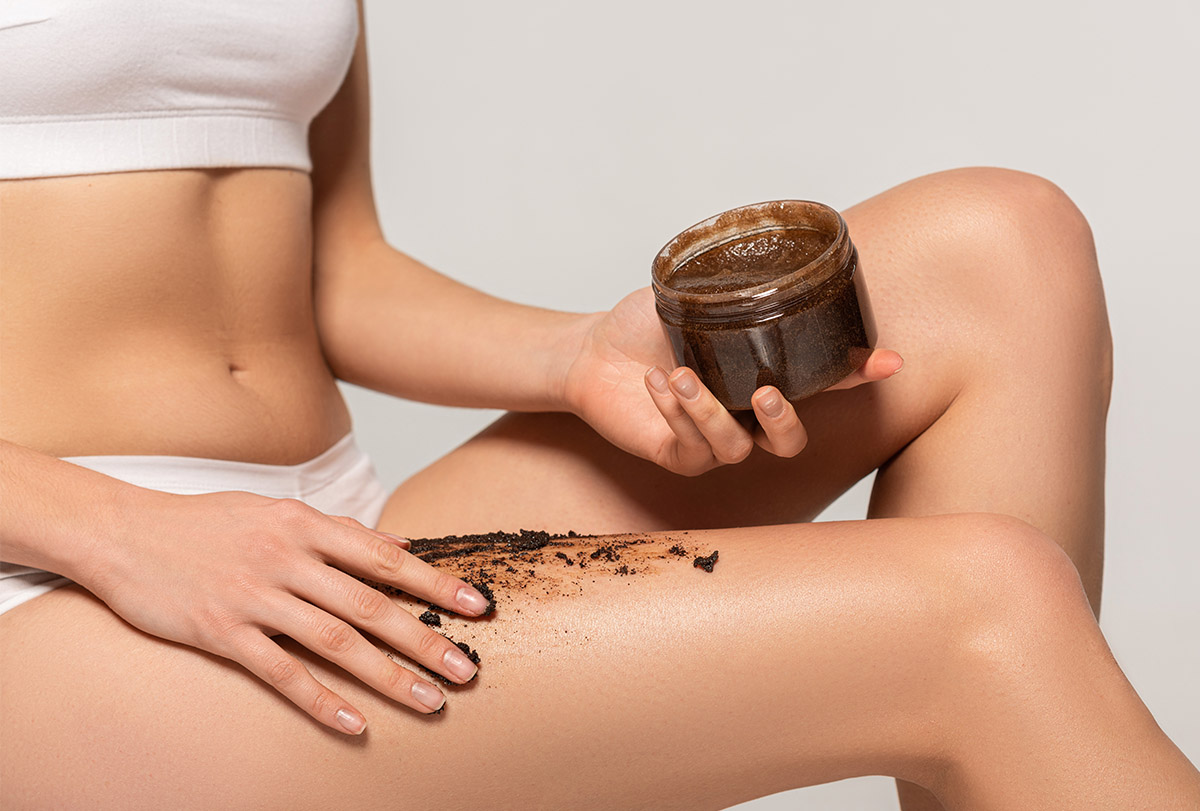
Ingrown hair develops due to hair growing from the hair follicle that curls and reenters the skin, further growing into the skin. This causes inflammation, pain, infection, and eruptions.
Ingrown hair is a common problem that can be easily avoided and treated with home remedies and self-care measures, which will be discussed in this article.
Home Remedies for Ingrown Hair
A mild problem of ingrown hair can generally be treated with the following at-home remedies.
Note: It is recommended to try the remedy which you find suitable and continue its use for a couple of weeks to test its effectiveness on your skin. If you do not notice any improvement, switch to another remedy. However, it is best to consult your doctor before trying these remedies, and seek medical care if the condition doesn’t improve or worsens.
1. Use a sugar scrub
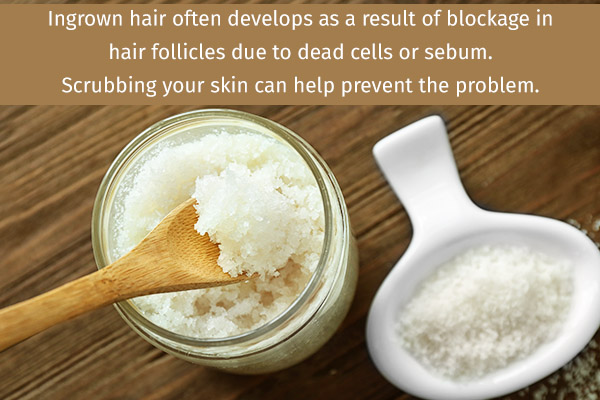
Since ingrown hair often develops as a result of blockage in the hair follicles due to dead cells or sebum, scrubbing your skin can help prevent the problem.
Sugar scrubs help manage infected hair follicles and exfoliate the dead skin cells off the skin surface, enabling the ingrown hair to grow out of the skin normally.
How to use:
- Mix 1 cup of sugar with ½ cup extra virgin olive oil, and add in a few drops of tea tree oil.
- Apply the paste to the affected area using a cotton ball.
- Scrub gently in a circular motion for a few minutes.
- Wash with lukewarm water.
- Repeat twice a week.
You can also use almond, orange peel powder, oats, and rice flour scrubs.
2. Soak with tea tree oil
Tea tree oil possesses antiseptic, antibacterial, and anti-inflammatory properties that can be helpful in treating ingrown hair. (1) The topical application of tea tree oil can help clear the debris in the pores, thus helping it open up, while reducing inflammation in the area.
How to use:
- Mix a few drops of tea tree oil with 4–6 ounces of warm water.
- Soak a clean dishcloth in it.
- Apply the cloth to the affected area as a warm compress.
3. Apply aloe vera
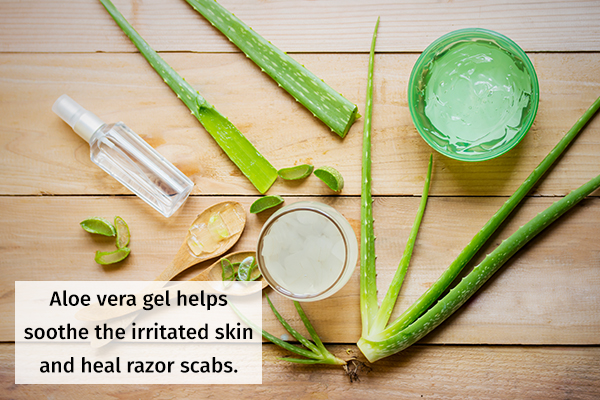
Aloe vera has antibacterial (2) and skin-healing properties, which can be beneficial to the skin. Aloe vera gel helps soothe the irritated skin and heal razor scabs.
How to use:
- Apply fresh aloe vera gel to the affected area.
- Wash using cold water after about half an hour.
- Use this remedy two to three times a week for effective results.
4. Dab some apple cider vinegar
Apple cider vinegar (ACV) acts as an antibacterial agent (3) and also helps remove the buildup of dead cells from the skin surface. This helps open up the pores, enabling the ingrown hair to grow in the correct direction.
How to use:
- Mix 1 tbsp of ACV in 2 tbsp of water.
- Using a cotton ball, dab this solution on your skin and allow it to air-dry.
- Wash your skin after 15–20 minutes.
- Repeat this remedy up to three times a day.
Note: Make sure to dilute ACV before use. Conduct a patch test before using to check for any sensitivity.
Self-Care Measures to Treat Ingrown Hair
The following self-care measures can be useful in the treatment and prevention of ingrown hair:
1. Prepare your skin for shaving
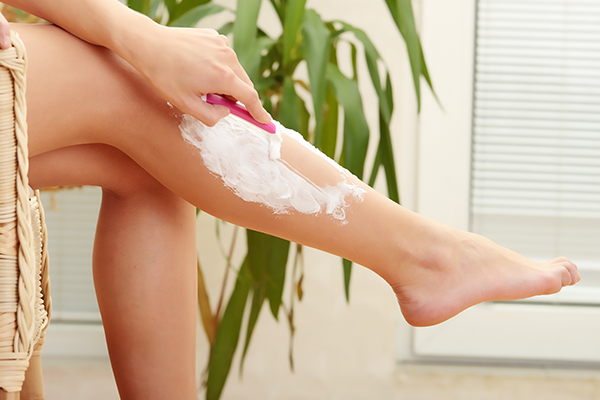
It is suggested to scrub your skin before shaving to unclog the pores. Also, pre-soak the area in warm water. Doing so hydrates the skin and softens the hair, thus reducing the chances of the hair reentering the skin. (4) You can use shaving creams or gels before shaving to soften the hair.
2. Shave properly
It is important to follow a proper shaving technique, which includes the following:
- Rinse your blade after every stroke.
- Avoid pulling your skin taut while shaving.
- Do not shave too close to the skin.
- Prefer a single-blade razor.
- Shave in the direction of the hair growth.
- Shave in as few strokes as possible.
- Educate yourself on how to shave each area with different strokes and pressure.
3. Change your razor frequently
It is important to change your razor frequently as blunt razors can increase the chances of cuts and irritation.
4. Apply a moisturizer
Keep your skin moisturized, especially after shaving.
5. Exfoliate your skin
It is common to develop ingrown hair if your hair follicles are blocked, which generally occurs due to flaky skin or excessive natural oils.
It is suggested to scrub your skin to prevent the problem. Moreover, regular scrubbing helps remove the dead skin layer, allowing ingrown hair to grow normally. You can use a washcloth or soft-bristled toothbrush to exfoliate the area around the ingrown hair.
6. Use OTC products
You can use chemical exfoliants that contain salicylic, glycolic acid, or lactic acid to help dissolve the skin cells that have trapped the ingrown hair. You may also consult your doctor on the use of eflornithine, which retards hair growth, especially when used with laser therapy. (5)
7. Try alternative hair removal methods
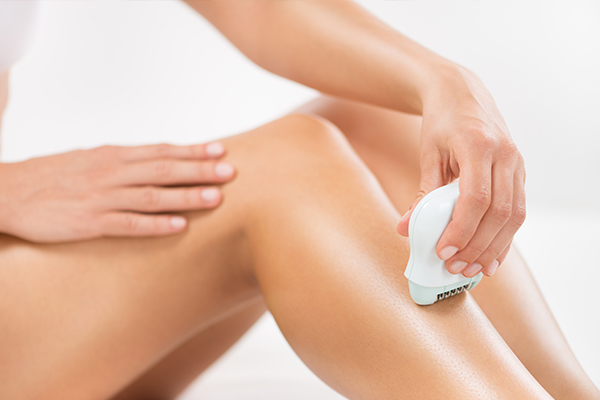
The following hair removal tools can help limit the chances of ingrown hair:
- Electric razor or clipper
- Chemical hair remover
Conduct a patch test before using these tools as they may irritate the skin.
8. Wear loose clothes
The use of tight clothes prevents the skin from breathing, thus increasing the chances of ingrown hair. (6)
9. Use ice compress after waxing
Wrap a few ice cubes in a clean cloth and use it as an ice compress over freshly waxed skin to help close the pores and, thus, prevent ingrown hair.
10. Apply a warm compress
A warm compress can help soothe and relax the skin, especially if itchiness and inflammation occur.
11. Avoid removing ingrown hair at home
While it may seem a simple procedure, it is best to avoid removing ingrown hair at home as it can lead to scarring and infection.
12. Refrain from scratching the hair
Avoid picking or scratching ingrown hair to relieve itching as this can lead to scarring.
Final Word
While ingrown hair is a common, mild problem, it can be visually bothersome and a constant source of irritation. You can treat ingrown hair at your home with easy-to-do natural remedies.
It is also important to make changes in your skin care and hair removal routines to prevent and manage ingrown hair. However, if the ingrown hair becomes infected or you notice pustule formation, it is essential to consult a doctor to prevent further complications.

- Was this article helpful?
- YES, THANKS!NOT REALLY


